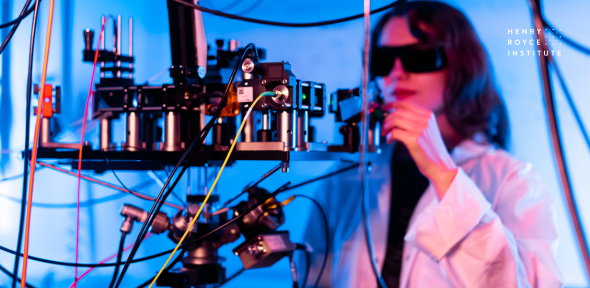
The Cambridge Nanoscale Quantum Sensing and Imaging Suite (CANSIS) uses atomic defects in nanoscale diamond crystals to image ultrasmall variations in local temperature and magnetic field with a 10-nm spatial resolution. The suite currently hosts two measurement systems.
Ambient Temperature Nanoscale Thermal and Magnetic Imaging System
The first system, custom-designed in collaboration with Asylum Research, integrates a scanning probe with optical detection of the diamond defects. The dynamic range of the system spans DC to MHz with sub mT and mK resolution for the magnetic and temperature sensing modes, respectively. The technique is non-invasive and thus enables the characterisation of surface and interface effects in highly sensitive samples with nanoscale magnetic features. The system is also ideal for probing caloric effects in thin films and devices: mK sensitivity enables the mapping of transient heat in high bandwidth devices and circuits with nm spatial resolution. In particular, this capability enables measurements and characterisation of devices for energy-efficient ICT during testing operations under ambient conditions.
The imaging system is housed in a temperature-controlled and vibrationally isolated housing which enables <0.5 K temperature stability and <5 nm drifts over the course of several hours.
If your research could benefit from this nanoscale thermal and magnetic imaging tool or if you would like more information on its capabilities, please contact the Facility Manager Dr Helena Knowles (hsk35@cam.ac.uk).
Low Temperature Nanoscale Magnetic Imaging System
The second system consists of a closed-cycle cryogenic atomic force/confocal microscope which can operate at 300K down to 2.8K (attoAFM/CFM + attoDRY1000). Equipped with diamond probes containing a single nitrogen-vacancy defect at the tip apex, the imaging system can probe magnetic fields spanning DC to MHz with micro-T magnetic resolution and 10-nm spatial resolution.
Owing to the single-spin nature of the nitrogen-vacancy defect, this system is ideal for imaging emergent magnetic and transport phenomena in low dimensional materials such as skyrmions, magnons, and edge currents, with virtually no perturbation. The system comes with a ±9-T superconducting magnet. The scan range is 30x30 microns at room temperature and 14x14 microns at 2.8K.
If your research could benefit from this variable temperature nanoscale imaging tool or if you would like more information on its capabilities, please contact the Facility Manager Dr Helena Knowles ( hsk35@cam.ac.uk ).
